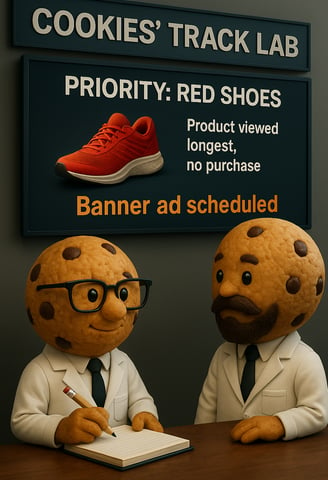🍪 The User Accepted the Cookies' Request — Time to Get to Work
Uncovering the World We Never Saw - Story 1


Note: This fictional story is designed to illustrate how cookies work online, using a cartoon-style scene to simplify the concept. Real explanations are included throughout the story.
Introduction
A user begins browsing different websites, searching for a new pair of running shoes.
When she lands on a sportswear site, a pop-up appears:
“This site uses cookies — do you accept?”
She clicks “Accept” without a second thought.
That’s when the Cookies team springs into action.
Although they don’t know who this new visitor is, they begin observing her browsing behaviour.
She’s looking at red running shoes in the women’s section — so the cookie reporter assumes:
“Looks like a woman is browsing. Let’s inform the team.”
The image shown on the cookie’s screen? It’s not real — just a fictional avatar, based on patterns from past visitors who viewed similar items.
No name. No personal info. Just a guess based on what’s being clicked.
The cookie reporter now prepares a quick update:
A new visitor is browsing red running shoes and spending more time on that product page than anything else.
It’s time to alert the tracking and marketing teams — just in case this visitor doesn’t buy right away.
What’s Really Happening Here?
For now, the cookie tracking system is only aware of the user’s activity, and nothing else.
But based on what the user browses, like spending time on women’s red running shoes, the system can make an educated guess about the type of buyer.
This is sometimes called a buyer persona.
A buyer persona is a general profile of a typical customer for that kind of product, including things like age group, interests, or shopping habits.
In this case, the user focused on one particular pair of shoes more than anything else in the store — a strong sign that this is the item she’s most interested in.


No Purchase Detected — Launch the Next Operation!
How do cookies recognise someone without knowing who they are?
Cookies don’t know your name, email, or any personal details.
What they do recognise is the device or browser you're using.
When the user first accepted the cookie request, a small bit of data — a “cookie” — was stored in her browser.
So when she visits the site again, even days later, that cookie quietly signals:
“Hey, this browser has been here before.”
That’s how the system knows it’s the same visitor, even though it still has no idea who she is.
The cookies in the lab now recognise that this user keeps coming back to the same red running shoes in the women’s section.
She’s spending a lot of time looking… but not buying.
That’s a strong signal: she’s interested, but something is holding her back.
So, the Cookies’ Lab team sends the update to the Cookies’ Marketing Team.
Time to launch a targeted ad — maybe a gentle reminder, or even a special discount.
What’s really happening here?
When the user leaves the site without buying, a small bit of data stays in her browser, showing that the red running shoes were the product she viewed the most.
Later, when she visits another website that shows ads, that same data helps display a targeted ad, often featuring the exact same shoes.


It Took a Few Ad Attempts, but We Finally Made the Sale with a 50% Discount
A few days have passed since the user visited the site.
She didn’t buy the shoes at first — maybe she got distracted or changed her mind.
But the Cookies didn’t give up.
After the Cookies’ Lab team reported the visitor’s strong interest, they passed the intel to the Cookies’ Marketing Studio.
The team launched a series of targeted ads, starting with the shoes at full price.
They waited, watched, and then noticed a key opportunity:
The same shoes went on promotion — 50% off, and only a few were left in her size.
The cookie marketers acted fast, rolling out a few final ads as a last effort to bring her back.
And it worked.
She saw the offer.
She clicked.
She bought the shoes.
And now?
She’s back — and the purchase is complete.
Inside the Cookies’ Marketing Studio, the team erupts in celebration:
“We did it!”
“Great job on that final ad!”
“All departments, mission complete!”
They still don’t know who she is.
But they know the job is done:
Interest became action.
A product was sold.
The cookies move on to the next visitor.
What’s Really Happening Here?
While our cookie characters are fictional, the process they represent is real — and happening in the background every day.
When you accept cookies, websites can remember what you looked at — even if you didn’t buy anything.
They don’t know your name or who you are. But they track your activity on that site and may show you targeted ads later, especially if they notice you were very interested in something.
That’s how cookies quietly help marketing teams turn browsing into buying.



